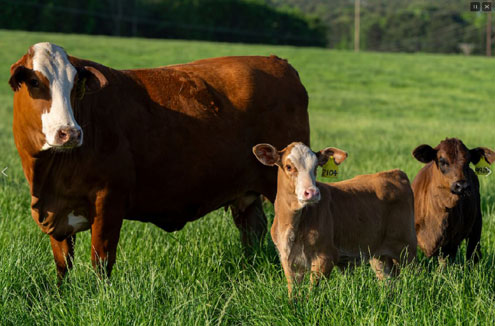Constrained cattle supplies and strong beef demand continue to fuel record prices at all levels of the U.S. beef market – from sale barns to grocery aisles, said Texas A&M AgriLife Extension Service experts.
Jason Cleere, Ph.D., AgriLife Extension statewide beef cattle specialist in the Texas A&M Department of Animal Science, Bryan-College Station, said cow/calf producers are realizing strong calf sale prices as a result of strong consumer demand for beef and low cattle supplies.
The national cattle herd continues to hover at historically low numbers following bouts of drought across major beef-producing states, including back-to-back years of extreme drought across Texas.

The national beef herd hit a 73-year low in January 2024 at 28.2 million head. Beef herd numbers have increased slightly to 28.7 million head, according to the U.S. Department of Agriculture July cattle inventory report, but cow-calf prices continue to reach new heights.
Cleere said feeding cattle to heavier weights has helped make up for lower cattle numbers, but beef production is down year-over-year overall. Cleere said the herd size coupled with strong consumer demand at the retail level has continued to fuel historically high prices for cow-calf producers.
“Retail prices are high, but there is still strong consumer demand,” Cleere said. “On the other end of production, you have ranchers capitalizing on record calf prices and asking, ‘How long are these high calf prices going to last?’”
Cow/calf biology weigh on U.S. beef market
David Anderson, Ph.D., AgriLife Extension economist in the Texas A&M Department of Agricultural Economics, Bryan-College Station, said low herd numbers and fewer market-ready calves are fueling record high prices at all levels of the beef market.
“We’ve got record high calf prices and record high fed cattle prices, and that is fueling record high beef prices on the wholesale and retail side,” he said. “Beef supplies have been particularly low since April while the demand from meatpackers and ultimately consumers has been strong.”
Nationally, Anderson said 300-400-pound calves were averaging $4.67 per pound while 500-600-pound calves were bringing $4.17 per pound on average. Localized sale prices have been even higher.
A weekly price-trend report by Jason Banta, Ph.D., AgriLife Extension beef cattle specialist, Overton, shows the average high price reported by six Central and East Texas auctions was $5.25 per pound for 300-400-pound calves and $4.70 per pound for 500-600-pound calves.
Anderson said the present market is also a good snapshot of how beef production cycle dynamics can influence supply and ultimately prices throughout the year.
Springtime is calving time for most cattle operations, he said. Those spring-born calves will go to auction in the fall. That influx of supply tends to create a price low point for the year whereas fall- and winter-born calves are hitting the market through spring and summer.
“It’s the biology of when calves are born and how fast they grow,” he said. “A decent number to go by from birth to finishing weight is 18-20 months, and that cycle can ripple through the sale barns all the way to the grocery store.”
Margins improve for Texas ranchers
The USDA Economic Research Service estimated the value of U.S. beef cattle and calf production at more than $83 billion in 2024. Record calf prices have been “tremendous” for Texas cattle producers who endured years of drought and high input costs, Anderson said.
Cleere said margins for cow/calf producers have improved as grazing around the state improved and input costs fell some. Ranchers are holding back replacement heifers, but better margins continue to incentivize selling those future calf-producing cows at rates that do not signal broader growth of the Texas or U.S. herd.
Anderson said individual producers may be utilizing excellent grazing conditions to keep or buy heifers to capitalize in the future, but most are seeing profitability now and taking it.
Both Anderson and Cleere expect calf prices to continue trending upward in 2026. Their upward price trajectory could steepen if more producers begin holding back more heifers for future calf production.
“Holding back heifers would really reduce the supply of calves for sale, and that usually drives prices even higher,” Anderson said. “You can’t discount the effect of rain and the good grazing conditions, which can lead to higher prices too, especially at local levels. But even with all that good grass, the incentive to sell is strong with these record high prices.”
Ranchers should plan for best and worst
With no signs of a herd rebuild, Cleere recommends cow/calf producers find efficiencies where they can optimize profitability while prices are high. Reproductive efficiency, nutrition and herd health practices, forage management and operational improvements that reduce long-term costs can all factor into increased productivity.
Preparing for best- and worst-case scenarios can give producers the ability to adjust their strategies, he said.
“It’s easy to make a profit right now,” he said. “But that is going to change, and we know eventually times will get leaner.”


